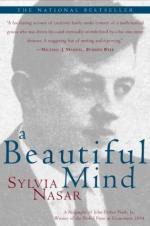
|
| Name: _________________________ | Period: ___________________ |
This test consists of 15 multiple choice questions and 5 short answer questions.
Multiple Choice Questions
1. John Forbes Nash, Jr.'s relationship with Eleanor lasted until what year?
(a) 1954.
(b) 1956.
(c) 1960.
(d) 1957.
2. Where was John Forbes Nash, Jr. born?
(a) Chicago, Illinois.
(b) Bluefield, West Virginia.
(c) Tacoma, Washington.
(d) Sierra City, California.
3. John Forbes Nash, Jr. became interested in mathematics in his youth while reading what book?
(a) Men of Mathematics.
(b) The Geometry of Humankind.
(c) The Power of Equations.
(d) The Math Wizard.
4. Between the ages of twenty-four and twenty-nine, Nash had relationships with how many men?
(a) Three.
(b) Two.
(c) Eight.
(d) Zero.
5. What is a situation in which no player can improve his situation in game theory?
(a) Stalemate.
(b) A zero-sum game.
(c) Equilibrium.
(d) End game.
6. When was the Rockefeller Foundation established?
(a) 1920.
(b) 1913.
(c) 1907.
(d) 1916.
7. John Forbes Nash, Jr. arrived at Princeton in what year, in Chapter Three?
(a) 1948.
(b) 1955.
(c) 1941.
(d) 1952.
8. How old was John Forbes Nash, Jr. when he arrived at Princeton in Chapter Three?
(a) Nineteen.
(b) Seventeen.
(c) Thirty.
(d) Twenty.
9. Nash's theorem in Chapter Fifteen basically said that it is possible for every manifold to find a part that corresponds to what?
(a) The Intermediate object.
(b) The original object.
(c) A basic equation.
(d) The end object.
10. In what year was John's sister Martha Nash born?
(a) 1912.
(b) 1918.
(c) 1930.
(d) 1907.
11. In Chapter Twenty, Nash was challenged to solve the problem of what?
(a) The Manhattan Project.
(b) Game theory.
(c) The Pythagoreon Theorum.
(d) Manifolds.
12. Kriegspiel refers to a chess variant invented by whom in 1899?
(a) Lloyd Shapley.
(b) Albert Einstein.
(c) Georg von Rassewitz.
(d) Henry Michael Temple.
13. What was the name of John Forbes Nash, Jr.'s mother?
(a) Betsy.
(b) Rebecca.
(c) Cynthia.
(d) Margaret.
14. Nash met with von Neumann to discuss his ideas regarding what in Chapter Ten?
(a) The continuum hypothesis.
(b) Riemann's Hypothesis.
(c) Manifolds.
(d) Game theory.
15. Where was Lloyd Shapley from?
(a) Cambridge, Massachusetts.
(b) St. Louis, Missouri.
(c) Miami, Florida.
(d) Bangor, Maine.
Short Answer Questions
1. What was Eleanor's profession when she met John Forbes Nash, Jr. in Chapter Twenty-Three?
2. Where was Albert Tucker when Nash mailed the first draft of his thesis to him in Chapter Ten?
3. When was the original "Kriegsspiel" game developed?
4. John Forbes Nash, Jr. won a Westinghouse Scholarship to study where in Chapter One?
5. John Forbes Nash, Jr. became interested in mathematics at what age?
|
This section contains 355 words (approx. 2 pages at 300 words per page) |

|




